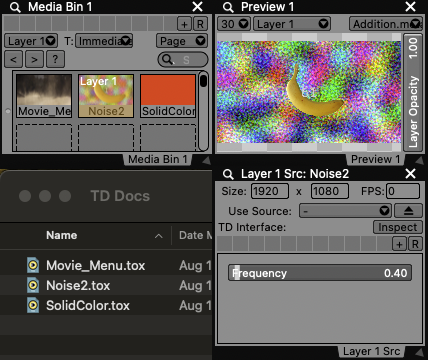VDMX6 is the biggest update for the live Mac visual tool in over a decade. Wait, no – it’s the biggest single-day news for Mac visuals in over a decade, full stop. Metal support, TouchDesigner integration, HAP updates, and more have implications beyond VDMX6 to other live visual tools, too.
Apart from VDMX6, Vidvox also develops open standards used by the rest of the live visual developer community. That includes the HAP video codec, which combines ultra-high resolution playback with features needed for real-time video that mainstream codecs don’t address. And there’s the cross-platform ISF standard [Interactive Shader Format] for interactive visual generators and effects. Each of those get some love alongside VDMX.
But lets talk VDMX6 – and why it just got a lot more relevant to TouchDesigner users.
Metalheads, rejoice
The open-ended, customizable, semi-modular UI that VDMX users love is still there. But the core of VDMX6 is a complete transition to Apple’s Metal API. There’s an entirely new rendering engine to make that happen, and according to Vidvox, this “opens new doors for upcoming features, improvements, and even more optimizations.”
OpenGL served the Mac well for a long, long time. But it’s deprecated on the Mac as all platforms (Linux and Windows included) move to newer APIs and graphic pipeline approaches. (The OpenGL story is old enough that Bungie’s Jason Jones was talking about what OpenGL would bring to the Macintosh when Halo debuted at … Macworld. Pre-Microsoft/Xbox. In 1899. Sorry, in 1999. Same difference at this point.)
So Metal is all of these things at once. It future-proofs VDMX for macOS and Mac hardware as OpenGL goes the way of MTV News. It opens up new performance optimization possibilities and expanded creativity. And it provides a platform for Vidvox to explore more in the future.
I wrote recently about how Metal offers great new things (and you can count on using these sorts of tools together, too):
TouchDesigner in VDMX
This is just huge – add TouchDesigner compositions directly into VDMX as generators, effects, and even control data plug-ins. VDMX was already semi-modular, and you could already augment it with code. Now you can work with all of TouchDesigner’s visual development features. (The one caveat is licensing – you’ll need Education, Commercial, or Pro licenses for TouchDesigner, plus a Plus license for VDMX6.)

People are doing fascinating stuff with Syphon, Spout, NDI, and other formats and combining tools, but this opens up a greater degree of integration.
This is on top of VDMX5’s addition of Vuo support, so you have two ways of making integrated effects/transitions/generators visually:
New HAP R video codec
Vidvox’s HAP codec is of interest even beyond VDMX itself. They have a whole new iteration of HAP alongside the Metal engine. Think of higher-quality files in roughly the same size. Get started trying this yourself, developers. And VDMX6 users can use this right away, both with a new exporter and new engine support (via Metal).

More features
Other goodies:
- Improved tempo tracking, with full native support on Intel and ARM64 (Apple Silicon)
- Lower memory footprint and more efficient operation
- New ISF generators and FX, new visualizers (and more glitch!)
- New overlay effects category with Doodler, Cursor, Highlighter, and more. (Yeah, maybe drop Zoom and Teams and switch to VDMX6?)
- BlackMagic and Video Capture support is expanded/improved, including full duplex and low-latency audio capture from BlackMagic devices
- Alpha channel support for key streams from supported devices (and alpha output to external key streams)
- New color themes and improved UI

And there’s more. You’d expect this to require brand-new systems, but the recommended system starts at macOS 13 / M1 or better. (Intel Macs and macOS 12 are still supported, too, but you’ll want macOS 13 and Apple Silicon to benefit from performance improvements.)
Oh, and you can keep VDMX5 and VDMX6 on the same machine.
Holy crap it’s cheap
Times are hard. Artists are broke. Vidvox seems to feel our pain.
VDMX6 is $99.
Not only that, but VDMX6 Plus with TouchDesigner and Vuo composition support is a still-very-reasonable $249.
I saw the word “plus” and something about “pricing” and figured we’d be adding a digit, not making things cheaper. There are still educational / hobbyist discounts to make it slightly cheaper than this.
On top of that, Vidvox has what I think is the most generous upgrade policy I’ve seen anywhere:
Existing VDMX5 users who purchased their license after September 12th, 2023 are entitled to a free update to VDMX6 Plus.
All other VDMX5 users can write in to receive a coupon to get 100 USD off on VDMX6 Plus.
Customers who have a license of VDMX6 can get the full price off of their original purchase if they choose to upgrade to VDMX6 Plus later.
More on all of this:
I’m grabbing my copy now. More on this – including TouchDesigner integration – soon. And other developers working on HAP support, I’d love to hear from you. It’s all one happy friendly visualist community here. Long live Create Digital Motion.
I might even try to create a video, because this is not VDMX6.
PS – if you’re wondering why I would cheer on Apple going proprietary (Metal, which is unique to Mac platforms) over portable and open, you’re misunderstanding. Check, for instance, WebGPU, which replaces WebGL on Web platforms and has a structure far more similar to Metal, or Molten VK, which runs the cross-platform Vulkan on top of Metal. Basically, it’s not 1999 any more – Metal is the low-level API that makes sense on Apple platforms, and there are ways of porting code like shaders across platforms – Vidvox’s own ISF being a good case in point. And they allow artists to work at a higher level.